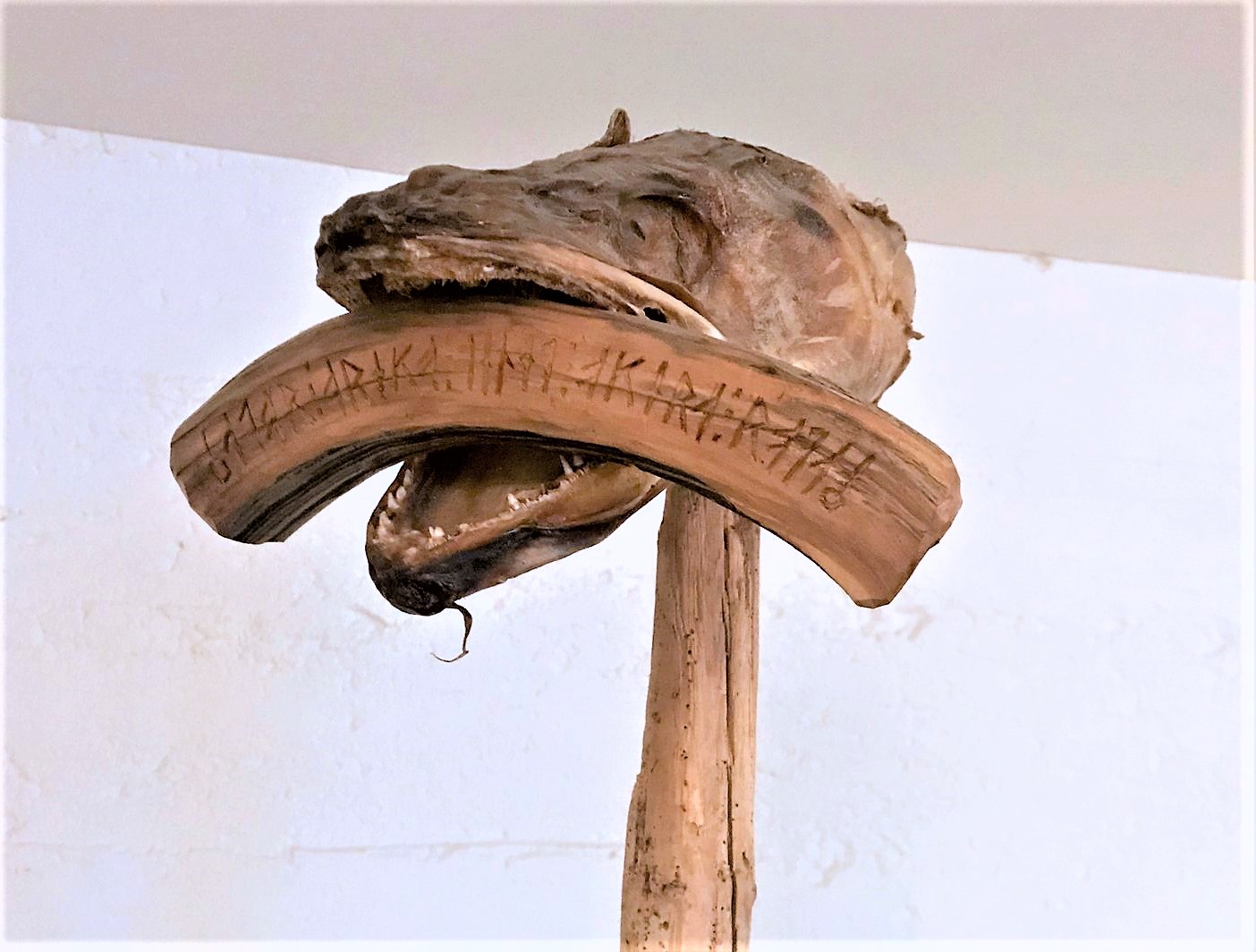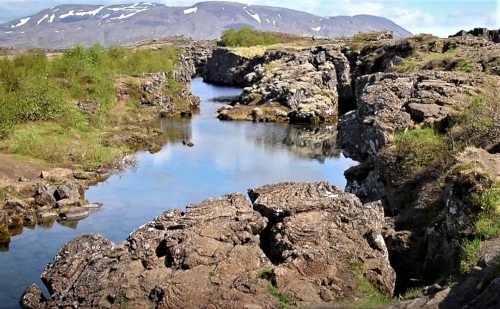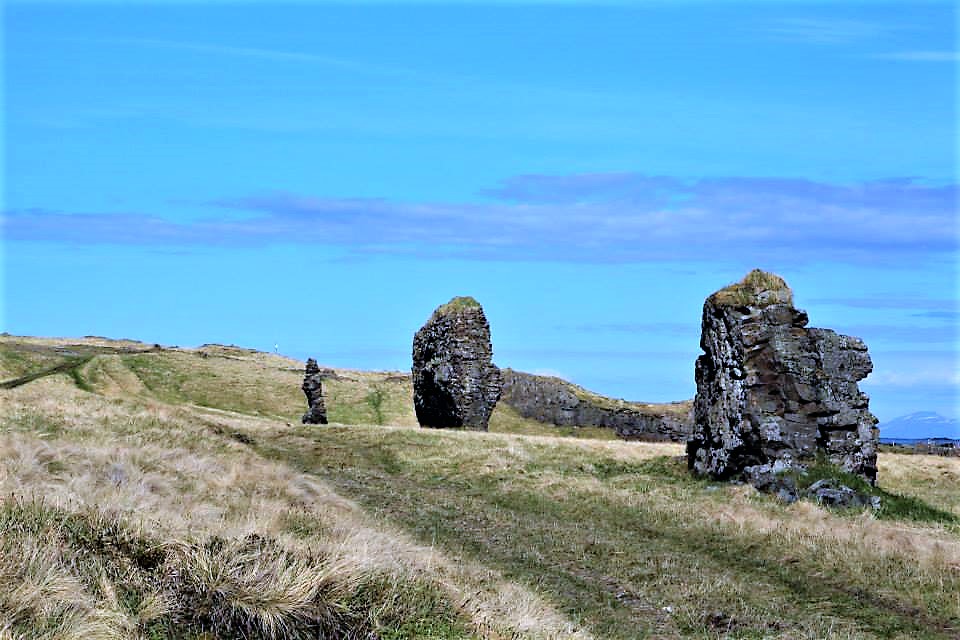Ocean of witchcraft and spells
Surrounded by a roaring ocean, the Icelandic people frequently turned to supernatural forces, such as witchcraft and spells for help. The sea was full of mysticism, something many fishermen will confirm. Consequently, the blurred lines between witchcraft and mirage were often hard to distinguish. On the other hand, there was no doubt in their minds what forces were at play.

Aphrodite - mouse of witchcraft and spells
At the bottom of the ocean lives a fascinating creature called Aphrodite aculeata, often called the sea mouse (Flæðarmús). The worm has beautiful hexagonal cylinders in the spine that cause a shimmering green and blue coloration. Modern scientists are paying this little worm as much attention as the sorcerers performing witchcraft and spells.
Sea Mouse by Peter is licensed under CC BY-NC-SA 2.0
Folklore and the sea mouse
Icelandic folklore explains that the sea mouse needs silver or gold to survive, which could be one explanation for why this little worm is associated with wealth. Another reason could be the shiny, shimmering light exuding from their spine, which looks like coins to seamen.
The sea mouse worm has been found as deep as 3,000 meters or 9,800 feet in the ocean, making it very difficult for light to penetrate. The neon-bright spine is the worm’s defense mechanism to ward off predators. In order to accomplish this, it uses light with nearly 100% efficiency.
Bioengineering turns into witchcraft and spells
Maybe the old-time seamen were on to something when it comes to this enigmatic worm, Aphrodite. Modern science wasn’t buying the whole witchcraft and spells thing. The cylindrical hexagonal shapes of its spine trap light and become photonic crystals, emitting iridescent light. This was the first time photonic crystals were discovered in a living organism.
Its spine has a biopolymer-based template that “contains more than 100,000 highly ordered, very high aspect ratio nanochannels” which are being used to create nanowires and nanotubes. By using the template, the researchers were able to create copper and nickel nanowires. The hope is to use this discovery for a more efficient fiber optics technology. Sounds like science is starting to sound more and more like witchcraft and spells.
This may sound far-fetched, but in 2010, researchers at the Norwegian University of Science and Technology created the largest existing nanowire by utilizing the sea worm’s magical features. Another example of scientists performing witchcraft and spells perhaps, as well.
Witchcraft and spells are not easy
One thing with Icelandic witchcraft and spells is that they don’t make it easy to accomplish. The rituals needed to prepare the spells make it almost impossible to follow.
Before catching the sea mouse, proper preparations have to be made. Get ready for some real old-fashioned witchcraft and spells. Firstly, collect hair from a virgin and weave it into a net. At the same time, make sure the net holes are so small that the mouse can’t escape through them.

Secondly, we need to prepare the magic symbol called the Ring Helm Stave.
The Ring Helm Stave
- Catch a strayed female black cat that has become wild.
- Collect the first menstrual blood from a virgin woman.
- Collect a raven's feather
Dip the tip of the feather in the blood and draw the stave on the cat’s skin. At a later point, this symbol will be attached to the virgin hair net.
Thirdly, we prepare the spell.


The spell
Once you’ve made the virgin hair net, follow these instructions:
- Sail out on the ocean to a spot where you know coins are at the bottom. This is where the sea mouse is most likely to be as it’s attracted to silver or gold.
- Lay the net out for one night and if you chose the right spot, a sea mouse will be caught in the net by morning.
- Retrieve the mouse and the virgin hair net. Bring it home.
- In the designated spot, lay down the hair net and the mouse on top. Some say the best spot is in a flour container.
- Make sure there is nowhere for the mouse to escape, as it will go back into the ocean.
- Cover the mouse with the Ring Helm stave that you drew on the cat skin. Never remove the stave.
- Steal money and put it in the hair net underneath the mouse. Never remove the stolen coin.
Once you’ve followed these steps, the mouse will continuously draw money from the ocean and put it in the same place as the stolen coin. That’s what we call pure witchcraft and spells.

Warning
The person who caught the sea mouse needs to make sure to bring it back out into the ocean or get rid of it some other way before they die. If this isn’t done, something terrible might happen. If the sea mouse finds its own way into the ocean after the person dies, it will create a terrible life-threatening tempest.
This type of tempest is called músarbylur or mouse squalls and is considered the most severe of them all.

The sorcerer
Jón Egilsson (1712-1799)
Not much is known about Jón, except that he had a son out of wedlock with a woman called Hallfríður Sigurðardóttir. Their, son, Bjarni Jónsson, also known as Hnausa-Bjarni (1760-1841), married a young lady named Guðfinna. She was the daughter of the famous priest and poet Jón Oddsson Hjaltalín. It’s through Rev. Jón Norðmann and Hnausa-Bjarni that this particular story of his father survives (or exists).
The sea-mouse
Jón Egilsson had been lucky enough to catch a sea mouse in a virgin hairnet, which he kept in a container full of flour. When Jón could feel death was near, he asked for help to release the mouse into the ocean. It was absolutely pertinent that it be done before he died. A fellow Icelander promised to take care of the sea-mouse, but unfortunately fell short on his promise. When Jón died shortly after on January 8, 1799, the sea-mouse was still inside his flour jar.
The promise-holder grabbed the container with the sea-mouse still inside and threw it into the river named Litla-Fura which was right by his home, Foss in Staðarsveit.
Litla-Fura river lies between Foss farms and Ölkelda Mineral Springs. Screenshot of image by GoogleMaps is licensed under fair use
The storm
People were worried about the sea-mouse and the potential tempest that would come if it got loose. Such was the belief in witchcraft and spells. Their fear was about to come true. While still in the river, the sea-mouse broke out of the container and escaped into the open sea, causing immense fury and rage in the ocean.o.
The night of Jón’s death a storm was brewing in the distance. Before long, the terrible storm had reached land. Consequently, it destroyed much of the southern and western parts of the country.
The maritime pilot from Höskuldsey, Bjarni Jónsson, heard what Hnausa-Bjarni had said. So, the next time they were at sea together he confronted him about using sorcery. However, Hnausa-Bjarni swore that neither him nor his father were sorcerers. As a result, the pilot threw him overboard and threatened to leave him there to drown, unless he took his lying words back about being a skilled sorcerer.
Hnausa-Bjarni was reluctant to take his words back. That is until the water was above his ears and the realization of drowning sank in. He admitted everything about his sorcery and the storm was a lie.
The aftermath
The storm was often called Básendaflóðið or the Flood at Básendar. It gets its name from the place Básendar which had been a large trading area since 1484. There was no doubt that the escape of the sea-mouse caused the terrible storm triggered by the most low-pressure area that had ever crossed Iceland.
The trading posts at Básendar were completely destroyed and never rebuilt. A Danish merchant living in Básendar, Hinrik Hansen 1748-1802, owned many of its stores, boats, and houses. Hinrik shared this horrific experience in a letter.
Hinrik's letter (paraphrased)
January 8th was just like every other evening when Hinrik, his wife, 4 children, and a maid got ready for bed. After the entire household lay peacefully asleep, Hinrik’s eyes opened wide. It was about 2:00 a.m. and the entire house creaked. It was noisy. Doors were slamming and he heard all kinds of banging outside and inside the house.
Meanwhile, Hinrik lied in bed listening to the storm thinking it would eventually stop. However, there was no sign of it stopping so, he got out of bed to see what was going on.
Básendar, which is located right below Stafnes. Screenshot of image by GoogleMaps is licensed under fair use
It was pitch black when Hinrik made his way towards the kitchen door to peek outside. He wasn’t expecting to see much in the dark night. He grabbed the door handle and as he opened it, it flew open and the ocean flushed into the house. Within a short moment, the entire main floor was flooded.
The escape
Hinrik rushed his family up to the loft. Getting to safety was the only thing on their minds so, there was no time to grab clothes or other belongings. Half-naked, the family and their maid huddled up, terrified up on the loft listening to the storm. It was too to see anything, but they knew the ocean was hugging the house and soon it would come for them, too.
About five hours later, the family was still up in the attic and the storm was as wild as ever. Hinrik knew it was only a matter of time before the tidal wave came to swoop them away. Hinrik broke the attic window and they all climbed out.
Shelter
With the storm pounding on their bodies, they waded through the flooded land. When they looked hard enough they could see all their belongings floating around them. Hinrik carried their youngest child in his arms as they struggled to make their way to the stable. They were hoping they’d be safe there since it was further away from the ocean and slightly higher up.
However, only 15 minutes after they got to the stable, the flood and the storm had reached them. Once again, they were forced to flee. This time they headed for the barn which was slightly higher up than the stable.
The barn was badly damaged, forcing them to climb over dangerous rubble to get inside. They stood inside the broken barn shaking and shivering until the weather eventually tore off much of the roof. They watched as the roof flew away and the parts still attached to the barn were waving in the wind. Yet again they were forced to escape, but this time they left the Básendar trading grounds.
Cold, wet and dark
The family reached out for each others’ hands and headed out for the unknown, possibly death. But the most important thing was that they were still all together.

After wading and crawling in the storm, they finally made it to Lodda (Loðvíksstofa) near Stafnes. The dirt poor farmer, Jón Björnsson and his wife received the family with much warmth and care.
For 14 days they crammed 19 people into a tiny room, ten of them were children. The distraught family felt much love and compassion from the generous farmers. However, they knew it was time to move on.

New home
They headed out to Stafnes and made a temporary home where they lived in severe poverty. Afterall, they had lost everything and had nothing to start with but each other. Hinrik and his wife made several attempts to retrieve some of their belongings in the rubble and what had flushed up on the beaches. They scoured the area both day and night hoping to find something they could use. But, in the end, all the strenuous efforts were in vein. His wife fell ill and Hinrik became too weak to continue on.
Soon after, the family moved to Keflavík where Hinrik died in 1802, only three years after the storm.
Hinrik's family
At the time of the storm, Hinrik and his wife had four children living at home. Their oldest son, Hans Símon (1779) was living abroad at the time.
Wife: Sigríður Sigurðardóttir (1761-1713) from Götuhúsin in Reykjavík.
Children living at home during the storm: Jóhann Pétur, Símon, María Lisebet and Jóhann Friðrik. After Hinrik’s death, the family moved to Reykjavík and his son’s became known as the Básendar brothers (básendabræður).









